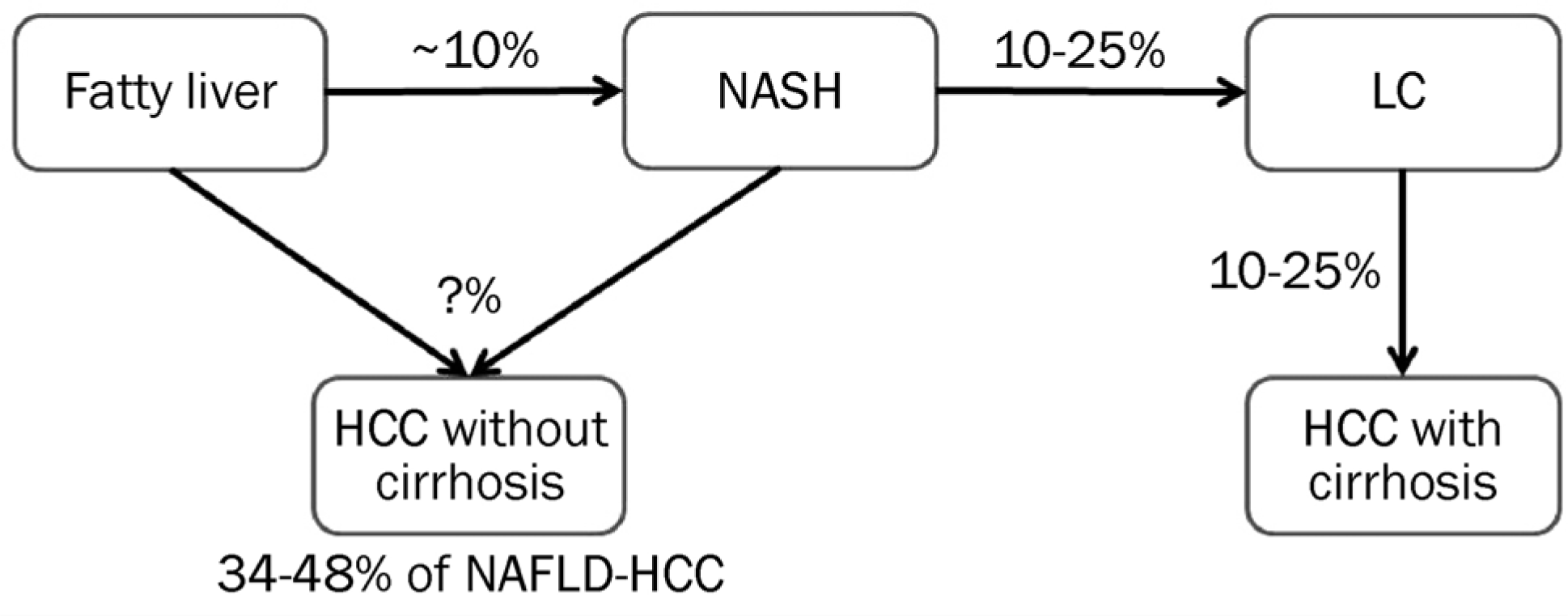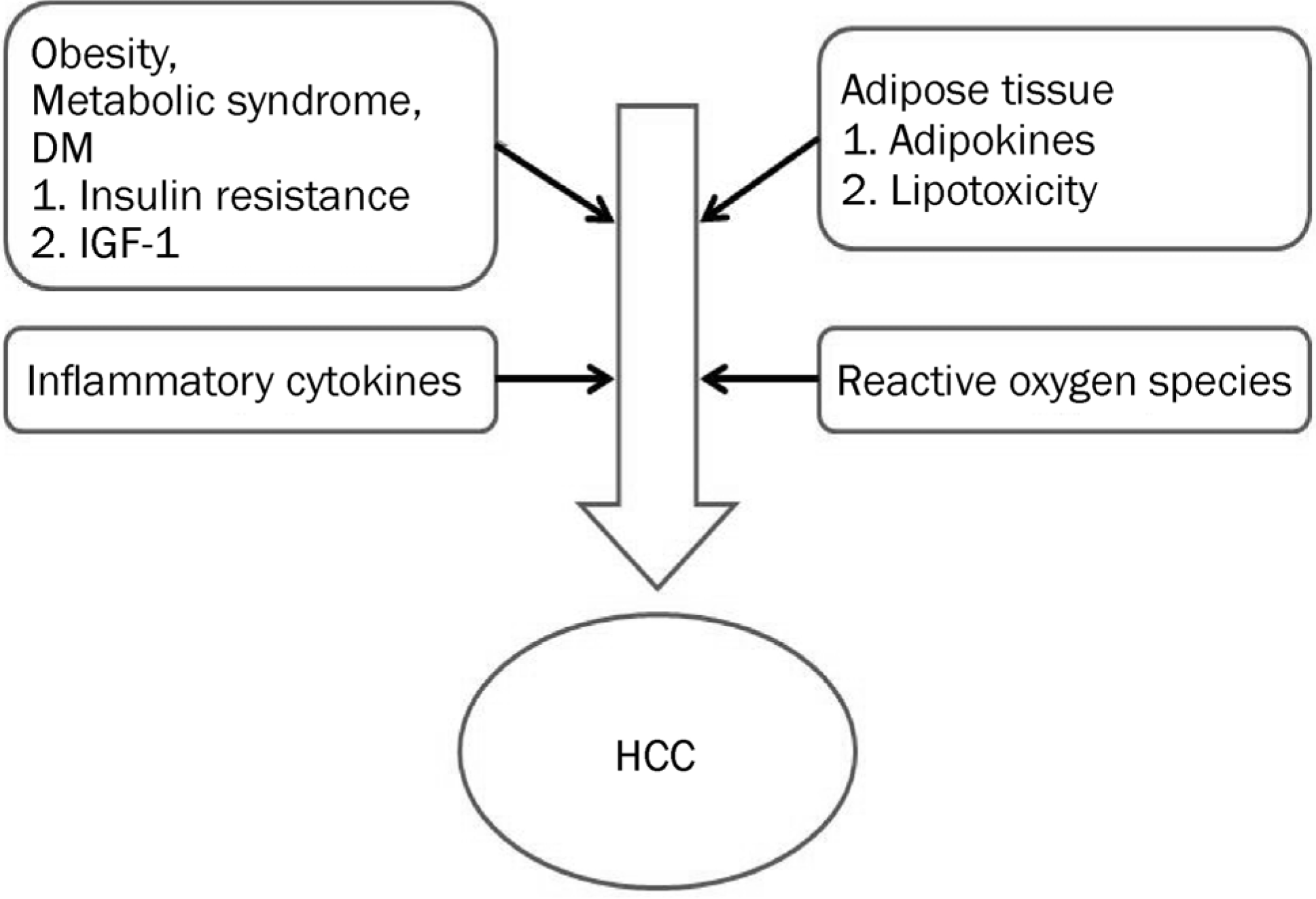Abstract
Non-alcoholic fatty liver disease (NAFLD) may be one of the important causes of cryptogenic hepatocellular carcinoma (HCC). NAFLD-related HCCs (NAFLD-HCCs) have the following clinical features: high body mass index, deranged lipid profiles, diabetes mellitus, hypertension, and metabolic syndrome. Among them, obesity, diabetes mellitus, and high Fe contents in the liver are risk factors of developing HCC in patients with NAFLD. Inflammatory cytokines, adipokines, insulin like growth factor-I, and lipotoxicity are inter-mingled and may cross react with each other to develop HCC. Because there is no guideline for early detection of HCC in patients with NAFLD, NAFLD-HCCs tend to be greater in size and in advanced stages when detected compared with hepatitis virus-related HCCs. Therefore, there is an urgent need of a surveillance program for the early detection of HCC. Treatment of NAFLD-HCCs is not different from other causes-related HCCs. However, patients with NAFLD-HCCs have cardiovascular disease and other metabolic problems, which may complicate treatment.
Go to : 
References
2. Bhala N, Angulo P, van der Poorten D, et al. The natural history of nonalcoholic fatty liver disease with advanced fibrosis or cirrhosis: an international collaborative study. Hepatology. 2011; 54:1208–1216.

3. Bugianesi E, Leone N, Vanni E, et al. Expanding the natural history of nonalcoholic steatohepatitis: from cryptogenic cirrhosis to hepatocellular carcinoma. Gastroenterology. 2002; 123:134–140.

4. Siegel AB, Zhu AX. Metabolic syndrome and hepatocellular carcinoma: two growing epidemics with a potential link. Cancer. 2009; 115:5651–5661.
5. Oh SW, Yoon YS, Shin SA. Effects of excess weight on cancer incidences depending on cancer sites and histologic findings among men: Korea National Health Insurance Corporation Study. J Clin Oncol. 2005; 23:4742–4754.

6. Paradis V, Zalinski S, Chelbi E, et al. Hepatocellular carcinomas in patients with metabolic syndrome often develop without significant liver fibrosis: a pathological analysis. Hepatology. 2009; 49:851–859.

7. Calle EE, Rodriguez C, Walker-Thurmond K, Thun MJ. Overweight, obesity, and mortality from cancer in a prospectively studied cohort of U.S. adults. N Engl J Med. 2003; 348:1625–1638.

8. Larsson SC, Wolk A. Overweight, obesity and risk of liver cancer: a metaanalysis of cohort studies. Br J Cancer. 2007; 97:1005–1008.

9. Marrero JA, Fontana RJ, Fu S, Conjeevaram HS, Su GL, Lok AS. Alcohol, tobacco and obesity are synergistic risk factors for hepatocellular carcinoma. J Hepatol. 2005; 42:218–224.

10. Ohki T, Tateishi R, Shiina S, et al. Visceral fat accumulation is an independent risk factor for hepatocellular carcinoma recurrence after curative treatment in patients with suspected NASH. Gut. 2009; 58:839–844.

11. Schlesinger S, Aleksandrova K, Pischon T, et al. Abdominal obesity, weight gain during adulthood and risk of liver and biliary tract cancer in a European cohort. Int J Cancer. 2013; 132:645–657.

12. Dyson J, Jaques B, Chattopadyhay D, et al. Hepatocellular cancer: the impact of obesity, type 2 diabetes and a multidisciplinary team. J Hepatol. 2014; 60:110–117.

13. Welzel TM, Graubard BI, Zeuzem S, El-Serag HB, Davila JA, McGlynn KA. Metabolic syndrome increases the risk of primary liver cancer in the United States: a study in the SEER-Medicare database. Hepatology. 2011; 54:463–471.

14. Rim MY, Kwon OS, Ha M, et al. Clinical features of non-alcoholic fatty liver disease in cryptogenic hepatocellular carcinoma. Korean J Gastroenterol. 2014; 63:292–298.

15. Pocha C, Kolly P, Dufour JF. Nonalcoholic fatty liver disease-related hepatocellular carcinoma: a problem of growing magnitude. Semin Liver Dis. 2015; 35:304–317.

16. El-Serag HB, Hampel H, Javadi F. The association between diabetes and hepatocellular carcinoma: a systematic review of epidemiologic evidence. Clin Gastroenterol Hepatol. 2006; 4:369–380.
17. Sorrentino P, D'Angelo S, Ferbo U, Micheli P, Bracigliano A, Vecchione R. Liver iron excess in patients with hepatocellular carcinoma developed on non-alcoholic steatohepatitis. J Hepatol. 2009; 50:351–357.

18. Fujita N, Miyachi H, Tanaka H, et al. Iron overload is associated with hepatic oxidative damage to DNA in nonalcoholic steatohepatitis. Cancer Epidemiol Biomarkers Prev. 2009; 18:424–432.

19. Greeve M, Ferrell L, Kim M, et al. Cirrhosis of undefined pathogenesis: absence of evidence for unknown viruses or autoimmune processes. Hepatology. 1993; 17:593–598.

20. Kawada N, Imanaka K, Kawaguchi T, et al. Hepatocellular carcinoma arising from non-cirrhotic nonalcoholic steatohepatitis. J Gastroenterol. 2009; 44:1190–1194.

21. Guzman G, Brunt EM, Petrovic LM, Chejfec G, Layden TJ, Cotler SJ. Does nonalcoholic fatty liver disease predispose patients to hepatocellular carcinoma in the absence of cirrhosis? Arch Pathol Lab Med. 2008; 132:1761–1766.

22. Kwon OS, Choi SH, Kim JH. Inflammation and hepatic fibrosis, then hepatocellular carcinoma. Korean J Gastroenterol. 2015; 66:320–324.

23. Hytiroglou P, Park YN, Krinsky G, Theise ND. Hepatic precancerous lesions and small hepatocellular carcinoma. Gastroenterol Clin North Am. 2007; 36:867–887. vii.

24. Baffy G, Brunt EM, Caldwell SH. Hepatocellular carcinoma innon-alcoholic fatty liver disease: an emerging menace. J Hepatol. 2012; 56:1384–1391.
25. Starley BQ, Calcagno CJ, Harrison SA. Nonalcoholic fatty liver disease and hepatocellular carcinoma: a weighty connection. Hepatology. 2010; 51:1820–1832.

27. Ogata H, Kobayashi T, Chinen T, et al. Deletion of the SOCS3 gene in liver parenchymal cells promotes hepatitis-induced hepatocarcinogenesis. Gastroenterology. 2006; 131:179–193.

28. Sakurai T, Maeda S, Chang L, Karin M. Loss of hepatic NF-kappa B activity enhances chemical hepatocarcinogenesis through sustained c-Jun N-terminal kinase 1 activation. Proc Natl Acad Sci U S A. 2006; 103:10544–10551.
29. Vinciguerra M, Carrozzino F, Peyrou M, et al. Unsaturated fatty acids promote hepatoma proliferation and progression through downregulation of the tumor suppressor PTEN. J Hepatol. 2009; 50:1132–1141.

30. Ertle J, Dechêne A, Sowa JP, et al. Non-alcoholic fatty liver disease progresses to hepatocellular carcinoma in the absence of apparent cirrhosis. Int J Cancer. 2011; 128:2436–2443.

31. Piscaglia F, Svegliati-Baroni G, Barchetti A, et al. Clinical patterns of hepatocellular carcinoma in nonalcoholic fatty liver disease: a multicenter prospective study. Hepatology. 2016; 63:827–838.

Go to : 
 | Fig. 1.Natural course of NAFLD. HCC can develop not only from cirrhotic liver, but also from non-cirrhotic liver. The prevalence of HCC without cirrhosis in NAFLD-related HCC was 34–48%. NAFLD, non-alcoholic fatty liver disease; HCC, hepatocellular carcinoma; NASH, non-alcoholic steatohepatitis; LC, liver cirrhosis; NAFLD- HCC, NAFLD related HCC. |




 PDF
PDF ePub
ePub Citation
Citation Print
Print



 XML Download
XML Download